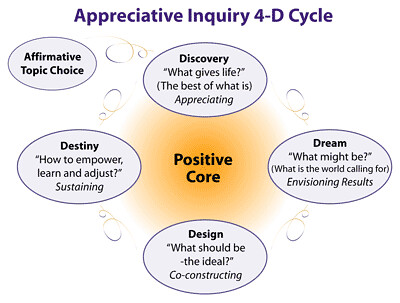Table of Contents
Appreciative Inquiry
No problem can be solved from the same level of consciousness that created it. We must learn to see the world anew.
Appreciative Inquiry (AI) is a method that focuses on creating preferred futures starting from the strengths, successes and unique attributes of a system or a group in the past and present. AI is grounded in a belief that in any situation there is something that works well. From this position of appreciation, it encourages the participants to discover their aspirations, desires and images of futures they would like to see. Rather than focusing on problems and attempting to solve them, AI postulates that words create worlds, that by focusing on the positive we can create futures we hope for. AI was developed by David Cooperrider and his colleagues at the Case Western Reserve University in the 1980s.
There are four phases of appreciative inquiry:
- Discovery: Appreciate what was and what is
- Dream: Imagine what might be,
- Design: Design what could be, what should be,
- Destiny: Create what will be.

At FoAM we often use the discovery phase as a warm-up exercise. The method as a whole has proven its worth when working with groups that are traumatised or in conflict. It reminds people that there is something worth persevering for and can help them see glimmers of hope in an otherwise difficult situation. Even if this process is followed through, for such groups a continued (coaching) support is needed. Sometimes it can feel even worse to go through a hopeful process with desirable results, only to be confronted with the old difficulties afterwards. If we can't be present to support the group after the workshop, we suggest that they form their own internal support groups (even as informal as having a joint lunch once a week) to help each other remember their aspirations and find ways to keep the plans alive.
Process
Appreciative Inquiry requires a spacious room (or several smaller rooms), with space for the whole group to work together, as well as private 'alcoves' for individual reflection and intimate dialogues. Before the process begins, you might want to consider designing the core question together with the participants. If there is enough time you can do it at the workshop, or online through a system such as All Our Ideas.
- Step 1: Discover: In this step the participants conduct interviews in pairs where they share stories of memorable (past and present) experiences related to the topic of inquiry. See more details about this step here
- The interview begins with storytelling: “Think about a time when XXX. Tell a story about that time. What was happening? What made it a great moment in time? What were you doing to contribute to this moment? What were others doing? What were the other dynamics that contributed to that time (available resources, people's attitudes, general atmosphere…)?
- What do you value about yourself in this situation?
- If you had three wishes about (the core question), what would they be?
- Step 2: Dream: discuss in the whole group some of the stories from the discovery phase. Focus on the behaviors, attitudes, emotions and resources that contributed to memorable experiences. Distill the main themes, such as causes of success, things to keep, strengths and visions.
- Step 2a: Envision: reflect on the themes from step 2 and begin to envision “what might be”. Note a few main threads, don't go into details.
- Step 3: Design: Create Possible scenarios by individually drawing a picture and/or write a short scenario that describes your preferred future that includes elements from the previous steps. Write the story in the present tense and include most if not all the themes.
- Step 3a: Bring all images of the future together in one large scenario with different points of view. Keep talking about the scenario in the present.
- Step 3b: Have a conversation about “what should be”, discuss and prioritise processes that the group thinks would work well. Look specifically at
- Self initiated actions
- Collective programmes
- Systems-wide innovations and changes
- Step 4: Deliver: Have a discussion about “what can you do tomorrow to begin implementing the possible scenario?”. End the discussion in clear names and descriptions of projects, actions, assignments and tasks.
- Step 4a: Timeline: place the names of the deliverables from Step 4 on a timeline. Include both short and long term horizons.
- Step 4b: Needs and offers: Invite the participants to individually write what they are willing to commit to and what they need in order to implement and deliver the plan. You can propose to write one need/offer per post-it.
- Step 4c: Board of needs and offers: Each participant presents their needs and offers and sticks the post-it on a board. If someone in the group can respond to their needs, the post-its are combined and 'resolved'. At the end of this step it should become clear what the group can do on their own and which external resources they need to reach their preferred futures.
Step 5: Look at the outcomes of all the steps and review if the plans are feasible and in line with the preferred future. Adjust if required. End with a clear list of next steps that the participants can follow to begin turning the scenario into reality.